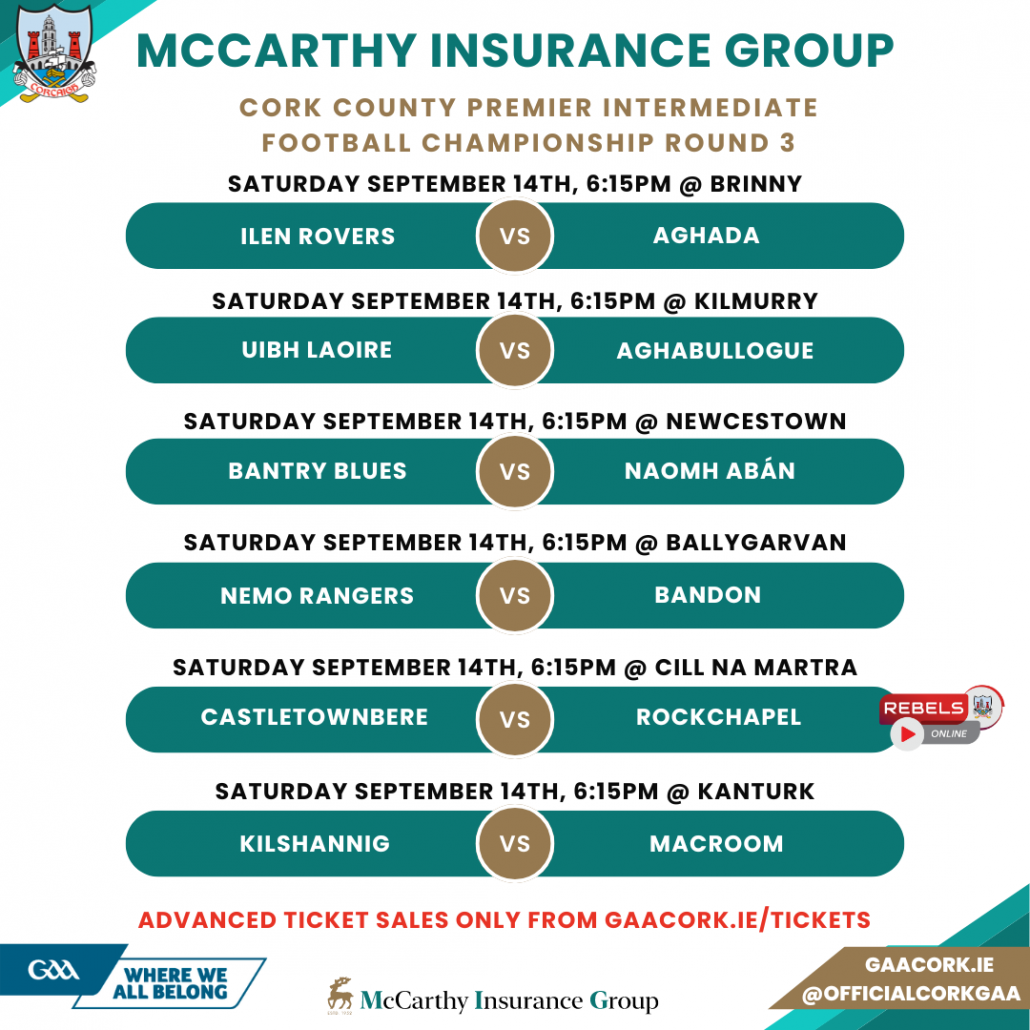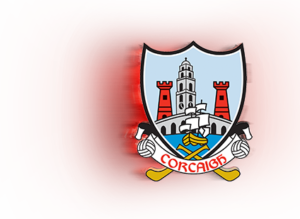
Premier Intermediate Football Round 3 ties promise exciting fare;
The McCarthy Insurance Group Cork Premier IFC is unusual among the various county championship grades in that just two knockout spots remain up for grabs with one round of group games remaining.
The three groups conclude on Saturday evening (all six games commence at 6.15pm) and four sides have already had their boarding passes for the knockout stages printed and scanned.
Bantry Blues, the defeated finalists of the last two years, have guaranteed their progress from Group 2 with wins over Nemo Rangers and Bandon, though first place has yet to be secured. On Saturday, they take on Naomh Abán in Newcestown and this battle of the blues will determine top spot. Naomh Abán sit on three points, having drawn with Nemo in their last outing, and would pass Bantry out with a win.
A draw would maintain the status quo and send both through while a Bantry win would put them top, possibly looking to a semi-final, and leave their Baile Bhúirne opponents waiting on the Nemo-Bandon result.
Nemo have a point and so must beat the Lilywhites in Ballygarvan while also trying to overturn a 13-point aggregate scoring-difference deficit. Bandon will be seeking to avoid the relegation play-off by picking up their first points.
Things are cut and dried in Group 1, where Uibh Laoire and Aghabullogue have both beaten Aghada and Ilen Rovers. The leaders’ meeting in Kilmurry will decide the top two places – Uibh Laoire have a healthy advantage on the scoring-difference front should a draw occur and a win for them will secure direct progress to the semi-final stage.
The other game, in Brinny, will be all about trying to finish third and escape any relegation worries. Aghada have the edge in the event of a draw and, if the East Cork side were to win, then Ilen’s scoring difference would almost certainly leave them in the relegation play-off, hoping not to endure a third straight demotion.
In Group 3, Kilshannig will finish top regardless of what happens in their game in Kanturk against Macroom – who will be seeking to evade having to contest the relegation play-off for the second year in a row.
Wins over Rockchapel and Castletownbere mean that, even if the Avondhu side were to lose, they would still have the head-to-head advantage over which side emerges from the winner-take-all clash in Cill na Martra. Rockchapel would take second place if that game were to finish in a draw. (Words courtesy Denis Hurley, The Echo)
Advanced ticket sales only from gaacork.ie/tickets





McCarthy Insurance Group PIFC Rd 3 results & Knockout Permutations;
McCarthy Insurance Premier IFC Round 3:
Ilen Rovers 1-10, Aghada 5-11 ;
Uibh Laoire 0-13, Aghabullogue 1-12 ;
Bantry Blues 1-7, Naomh Aban 1-9 ;
Nemo Rangers 4-7, Bandon 2-10 ;
Castletownbere 0-10, Rockchapel 0-10 ;
Kilshannig 3-10, Macroom 1-8 ;
The Knockout stages are listed hereunder;
Legends Episode 3 – Denis Coughlan
McCarthy Insurance Group Intermediate ”A” Football round 3 ties offer interesting ties;
The six remaining games in the IAFC take place at 4.30pm on Saturday. Gabriel Rangers in Group 1 and Boherbue in Group 3 are already through and both are in action against the teams in second place.
A draw will do Gabriels against fellow West Cork side Adrigole in Kealkill, but Adrigole would top the section with a win. If Gabriels were to win, then Kildorrery – two points behind Adrigole – would come second if they beat Dromtariffe in Churchtown and effected a seven-point swing in scoring difference.
It’s a similar situation as Boherbue take on Glanmire in Mourneabbey – the Duhallow side are on four points with their Imokilly opponents on three.
Glanmire’s scoring difference is +16 while that of St Finbarr’s, on one point in third, is -1. A loss for Glanmire and a win for the Barrs against Na Piarsaigh in Mayfield would call scoring difference into play but two big wins would be needed in order for the Togher side to progress.
In Group 2, Glanworth have a 100 percent record after two games as they clash with neighbours Mitchelstown in Araglen. However, Mitchelstown on two points have a scoring difference of +5 with Glanworth on +6, so any Town win would put them through if Ballinora were to beat St Vincent’s a force a three-way tie on four points.
Should Glanworth win, then Vincent’s would need to triumph by at least four points in Ovens in order to have a chance of taking second place on scoring difference. See the graphics for the fixtures each group below with the various permutations. (Words courtesy Denis Hurley, The Echo)
Advanced Ticket Sales only from gaacork.ie/tickets
Premier Intermediate Round 3 ties promise exciting fare;
Premier Intermediate Football Round 3 ties promise exciting fare;
The McCarthy Insurance Group Cork Premier IFC is unusual among the various county championship grades in that just two knockout spots remain up for grabs with one round of group games remaining.
The three groups conclude on Saturday evening (all six games commence at 6.15pm) and four sides have already had their boarding passes for the knockout stages printed and scanned.
Bantry Blues, the defeated finalists of the last two years, have guaranteed their progress from Group 2 with wins over Nemo Rangers and Bandon, though first place has yet to be secured. On Saturday, they take on Naomh Abán in Newcestown and this battle of the blues will determine top spot. Naomh Abán sit on three points, having drawn with Nemo in their last outing, and would pass Bantry out with a win.
A draw would maintain the status quo and send both through while a Bantry win would put them top, possibly looking to a semi-final, and leave their Baile Bhúirne opponents waiting on the Nemo-Bandon result.
Nemo have a point and so must beat the Lilywhites in Ballygarvan while also trying to overturn a 13-point aggregate scoring-difference deficit. Bandon will be seeking to avoid the relegation play-off by picking up their first points.
Things are cut and dried in Group 1, where Uibh Laoire and Aghabullogue have both beaten Aghada and Ilen Rovers. The leaders’ meeting in Kilmurry will decide the top two places – Uibh Laoire have a healthy advantage on the scoring-difference front should a draw occur and a win for them will secure direct progress to the semi-final stage.
The other game, in Brinny, will be all about trying to finish third and escape any relegation worries. Aghada have the edge in the event of a draw and, if the East Cork side were to win, then Ilen’s scoring difference would almost certainly leave them in the relegation play-off, hoping not to endure a third straight demotion.
In Group 3, Kilshannig will finish top regardless of what happens in their game in Kanturk against Macroom – who will be seeking to evade having to contest the relegation play-off for the second year in a row.
Wins over Rockchapel and Castletownbere mean that, even if the Avondhu side were to lose, they would still have the head-to-head advantage over which side emerges from the winner-take-all clash in Cill na Martra. Rockchapel would take second place if that game were to finish in a draw. (Words courtesy Denis Hurley, The Echo)
Advanced ticket sales only from gaacork.ie/tickets
Exciting Weekend of Round 3 Football Action on Rebels Online
Exciting Weekend of Round 3 Football Action on Rebels Online
An action-packed weekend of Round 3 Football Championship fixtures is upon us, and Rebels Online will be there to cover all the key moments! Along with live broadcasts, we will also provide regular score updates from across the other games taking place in the groups.
Here’s the schedule of live-streamed matches you won’t want to miss:
Premier Junior Football Championship (Round 3)
Glenville v Kinsale in Páirc Uí Rinn (Live on Rebels Online)
Intermediate A Football Championship (Round 3)
Mitchelstown v Glanworth in Araglin (Live on Rebels Online)
Premier Intermediate Football Championship (Round 3)
Castletownbere v Rockchapel in Cill na Martra (Live on Rebels Online)
Senior A Football Championship (Round 3)
Dohenys v O’Donovan Rossa in Rossmore (Live on Rebels Online)
Premier Senior Football Championship (Round 3)
Ballincollig v Éire Óg in Kilmurry (Live on Rebels Online)
Make sure to tune in and follow all the action live on Rebels Online!
Adult Coaching Conference